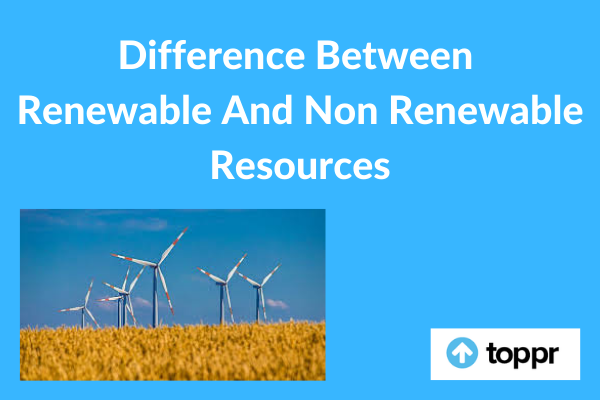Natural resources refer to the resources which are available without any actions of mankind such as sunlight, atmosphere, air, water, land, mines, vegetation, and animal life. Natural resources are of two types, namely, renewable resources and non-renewable resources. Human beings depend on both these resources. Let us study the difference between Renewable and Non-Renewable Resources.
What are Renewable Resources?
These are the natural resources that do not get depleted or exhausted even after their continuous consumption. These get replenished or replaced through natural processes during a finite amount of time. For example, sunlight and wind.
What are Non-Renewable Resources?
These are the natural resources that get depleted or exhausted with continuous human consumption and also do not get replenished or replaced. For example, mineral ores, fossil fuels, groundwater, etc.
Let us study the difference between Renewable and Non-Renewable Resources now.
Difference between Renewable and Non-Renewable Resources

Difference Between Renewable and Non-Renewable Resources
The important difference between Renewable and Non-Renewable Resources
| Parameters | Renewable Resources | Non-Renewable Resources |
| Depletion or exhaustion | There is no depletion in them with continuous consumption. | These get depleted with continuous consumption. |
| Examples | Sunlight, wind, water, vegetation, etc. | Mineral ores, fossil fuels such as coal and petroleum. |
| Impact on the environment | These emit low carbon and thus have a low carbon footprint. | These emit comparatively higher carbon and thus have a higher carbon footprint. |
| Upfront cost | The upfront cost is high. | The upfront cost is low. |
| Infrastructure | In order to harvest renewable energy, the cost of infrastructure is very high. | In order to harvest non-renewable resources, the cost of infrastructure is low and cost-effective. |
| Area | It requires a huge area for wind farms, etc. | It requires a smaller area, comparatively. |
FAQs about Renewable and Non-Renewable Resources:
Q.1. What is a windmill?
Answer: A windmill is a structure with sails or blades that converts the power of the wind into rotational energy. It uses renewable resources i.e. the wind power to generate electricity. Basically, there are two types of windmills namely, Horizontal and Vertical windmill.
Q.2. How can we conserve water in our daily life?
Answer. The simple ways to avoid the wastage of water are;
- Check all taps for leakages.
- Do not keep the tap open while shaving, brushing, washing, etc.
- Don’t wash your vehicles and driveways with pipe and too often.
- Use the water used for washing vegetables in watering the plants.
- Install the rainwater harvesting system at your home.






thanks for in lighting us
Thanks for lighting me more this aspect
Thanks for enlightening me more on this